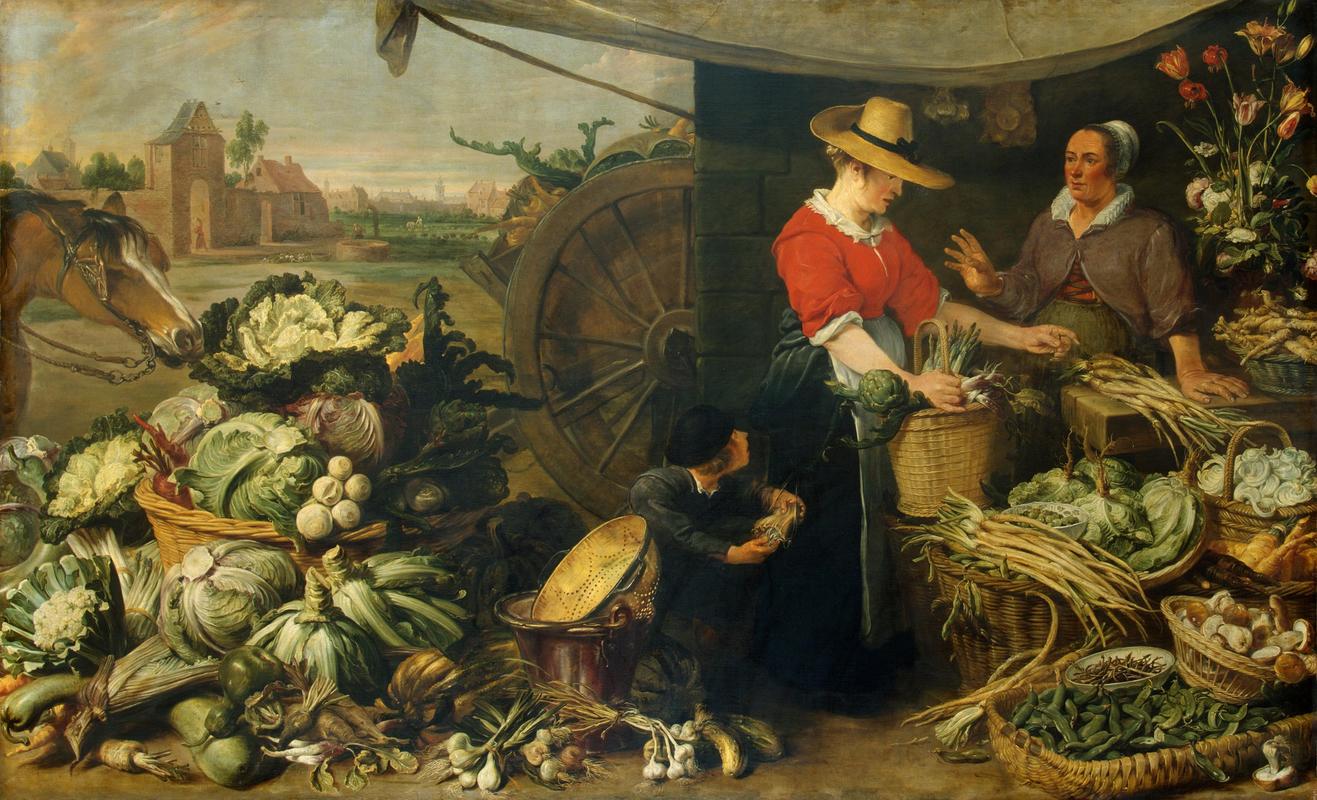More about Greengrocery Stall

Contributor
The Hermitage Museum, which has owned and maintained Frans Snyders' Greengrocery Stall since 1779, lists the work as part of a series called Shops.
Greengrocery Stall once hung in a dining room with Fishmonger's Shop, The Game Shop, and The Fruit Shop, also by Snyders. Shops is the only series of paintings in the legacy of Snyders, according to the Hermitage, and they are in the fortunate position of owning several. Good for them! By 1873, the Hermitage had amassed no fewer than fourteen Snyders works, while the great City of London boasted a grand total of none.
According to the Hermitage, this work is allegorical, incorporating hints of the incredibly popular motifs, explored by Giuseppe Arcimboldo and many others, of the four elements and the five senses. Whereas the fishmonger corresponds to the element of water, the greengrocer represents earth. The pickpocket in the center takes advantage of the blind spot of the vendor to steal her coin-purse, commenting on the sense of sight. It is similar to Rembrandt's allegory of sight, which shows an unscrupulous salesman hawking a pair of glasses to a blind man.
Among the many refreshing things about the Northern Renaissance is the fact that art was very often a collaborative practice. The cult of the romantic individual genius, paintbrush in hand, with a biography chock full of trials and tribulations, reached its fever pitch in the 19th and 20th centuries, and even continues today, but in the day of Snyders it wasn't very important whether a painting was composed by one, two, or several specialists. As was his habit, Snyders outsourced the landscape portion of the work—in this case, to his colleague Jan Wildens (1586-1653). Jørgen Wadum, conservationist of the National Gallery of Denmark, compares the population of all of Renaissance-era Netherlands to today's state of Maryland, and claims that in this time the country produced 50,000 paintings in a single year. This incredible rate of production was part of a dialogue between artists there and in Italy, where Wildens and Snyders soaked up some knowledge of the craft, and it's a critical aspect of the development of European painting in general.
At the same time, the high level of production created the vibe of a downtown flea market at high noon, with everybody competing fiercely to sell their work, and this pressurized environment led artists to specialize in increasingly limited areas. Snyders just didn't have time to do the landscape: it would have been like asking a great neurosurgeon to design a building—it just wasn't his area. Because of the specialization and competition of the buyer's market, it was quite common to compose works "on spec," without a commission, which was another reason to collaborate.
Sources
- "Снейдерс, Франс. 1579-1657; Вильденс, Ян (пейзаж). 1586-1653 Овощная лавка 1618 – 1621 гг." Hermitage, http://collections.hermitage.ru/entity/OBJECT/48288?avtor=2824&index=4.
- Atkinson, Joseph Beavington. An Art Tour to Northern Capitals of Europe. London: MacMillan, 1873.
- Gritsay, Natalya Ivanovna. Фламандская живопись XVII века: Очерк-путеводитель. Leningrad: Искусство. Ленингр. отд-ние, 1989.
- Kraske, Oliver. The Hermitage: Masterpieces of the Painting Collections. London: Scala, 2007.
- "Masters of still life and animal works." State Hermitage Museum, http://edu.hermitage.ru/catalogs/1421610829/themes/1421610953/article/1….
- Vlieghe, Hans. Flemish Art and Architecture, 1585-1700. New Haven: Yale University Press, 1998.
- Wadum, Jørgen. CATS Centre for Art Technological Studies and Conservation: Interdisciplinary Research Into Artists' Materials and Techniques. Copenhagen: Centre for Art Technological Studies and Conservation, 2018.











